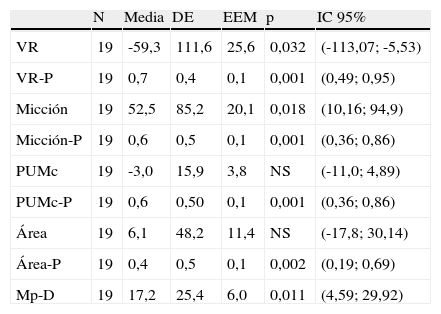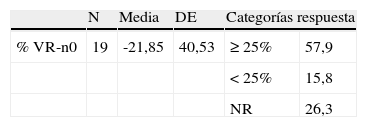Evaluar la eficacia y seguridad de la toxina botulínica en la hipertonía esfinteriana en pacientes con lesión medular (LM).
Pacientes y métodoEnsayo clínico no controlado en varones con hipertonía esfinteriana secundaria a LM. Se aplicaron 100 U de Botox® vía transperineal en esfínter uretral externo guiado con electromiografía y ecografía transrectal. Se determinaron los siguientes parámetros: volumen urinario residual (VR), presión uretral máxima de cierre (PUMc), volumen de micción (M) y porcentaje de micción (MP). Se valoró la incidencia de disfunción eréctil mediante cuestionario International Index of Erectil Function (IIEF-5 items).
ResultadosSe incluyeron 19 varones, con una media de edad de 40 años (extremos 22-56). El tiempo medio de seguimiento fue de 546 días (20 meses). Se realizó una infiltración cada 6 meses de promedio, con una media de 2,7 infiltraciones por paciente (extremos 1-7). El VR disminuyó 59,3ml (p=0,03), la micción aumentó 52ml (p=0,018) y el MP mejoró el 17,2% (p=0,011), mientras que los cambios en PUMc no fueron significativos. No empeoró la disfunción eréctil presentada ya previamente (IIEF-5: 11,4 a 13).
ConclusiónLa infiltración con toxina botulínica aplicada a esfínter uretral externo vía transperineal parece ser una eficaz y segura opción terapéutica.
To assess the efficacy and safety of botulinum toxin for sphincter hypertonia in patients with spinal cord injury (SCI).
Patients and methodsNon-control clinical trial on men with neurogenic detrussor-sphincter dyssynergia (DSD) due to SCI. 100 IU of Botox® were injected through the transperineal way on external urethral sphincter under electromyography and transrectal ultrasound guidance. The following parameters were determined: post-void residual (PVR), maximum urethral pressure (MUP), miction volume (M) and miction percentage (MP). The incidence of erectile dysfunction was evaluated using the International Index of Erectile Function questionnaire (IIEF-5 items).
Results19 men with an average age of 40years (ED 22-56) were included. The average time of monitoring was 546days (20 months). As an average, an infiltration was done every 6 months, with an average of 2.7 infiltrations per patient (1-7). PVR dropped by 59.3ml, p=0.03; miction raised to 52ml, p=0.018; MP was improved by 17.2%, p=0.011. Changes on MUP were not significant. Erectile dysfunction was not worse than the initial one (IIEF-5: 11.4 to 13).
ConclusionThe infiltration of the toxin into the sphincter through the transperineal way seems to be an effective and safe therapeutic option.
Artículo
Comprando el artículo el PDF del mismo podrá ser descargado
Precio 19,34 €
Comprar ahora








